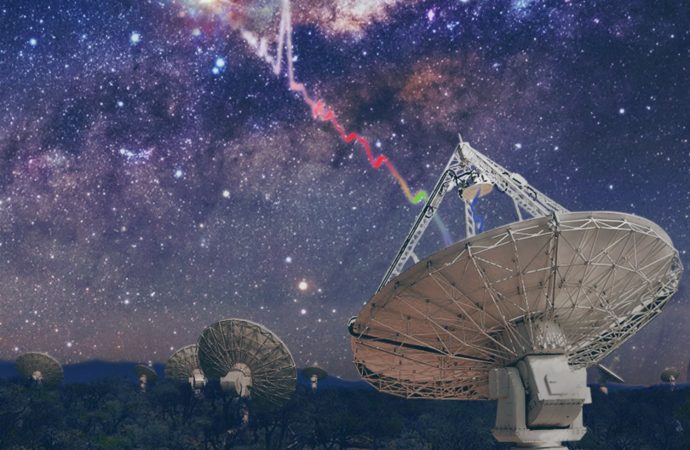Astronomers using CSIRO’s Australian Square Kilometre Array Pathfinder (ASKAP) at the Murchison Radio-Astronomy Observatory have nearly doubled the known number of fast radio bursts — mysterious and rarely detected bursts of energy from space. The team’s discoveries, reported in the journal Nature, include the closest and brightest fast radio bursts ever detected.
Fast radio bursts are brief, bright pulses of radio emission from distant sources.
These events have durations of milliseconds and exhibit the characteristic dispersion sweep of radio pulsars. They emit as much energy in one millisecond as the Sun emits in 10,000 years, but the physical phenomenon that causes them is unknown.
Theories range from highly magnetized neutron stars, blasted by gas streams near to a supermassive black hole, to suggestions that the burst properties are consistent with signatures of technology developed by an advanced civilization.
Despite considerable efforts over the past decade, only 34 fast radio bursts have been reported.
“We’ve found 20 fast radio bursts in a year, almost doubling the number detected worldwide since they were discovered in 2007,” said Dr. Ryan Shannon, an astronomer at the Swinburne University of Technology and the OzGrav ARC Centre of Excellence.
“Using the new technology of the ASKAP radio telescope, we’ve also proved that fast radio bursts are coming from the other side of the Universe rather than from our own galactic neighborhood.”

An artist’s impression of fast radio bursts; Shannon et al have shown that the brighter bursts are probably in galaxies that are quite nearby, while fainter ones are likely to be much more distant. Image credit: Swinburne University of Technology / OzGrav ARC Centre of Excellence.
Fast radio bursts travel for billions of years and occasionally pass through clouds of gas.
Each time this happens, the different wavelengths that make up a burst are slowed by different amounts.
“Eventually, the burst reaches Earth with its spread of wavelengths arriving at the telescope at slightly different times, like swimmers at a finish line,” explained Dr. Jean-Pierre Macquart, from the Curtin University node of the International Centre for Radio Astronomy Research.
“Timing the arrival of the different wavelengths tells us how much material the burst has traveled through on its journey.”
“And because we’ve shown that fast radio bursts come from far away, we can use them to detect all the missing matter located in the space between galaxies — which is a really exciting discovery.”
“We now know that fast radio bursts originate from about halfway across the Universe but we still don’t know what causes them or which galaxies they come from,” Dr. Shannon said.
The team’s next challenge is to pinpoint the locations of bursts on the sky.
“We’ll be able to localize the bursts to better than a thousandth of a degree,” Dr. Shannon said.
“That’s about the width of a human hair seen 33 feet (10 m) away, and good enough to tie each burst to a particular galaxy.”
Source: Sci News

































Leave a Comment
You must be logged in to post a comment.